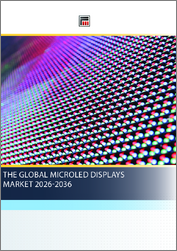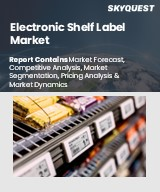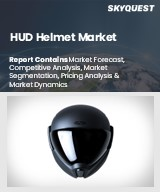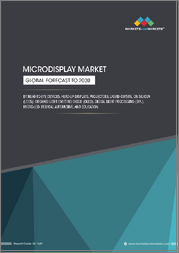
|
시장보고서
상품코드
1787970
세계의 디스플레이 시장 예측 : 유형, 패널 사이즈, 해상도, 기술, 용도, 최종 사용자, 지역별 분석(-2032년)Display Market Forecasts to 2032 - Global Analysis By Display Type (Flat Panel Display, Flexible Panel Display and Transparent Display), Panel Size, Resolution, Technology, Application, End User and By Geography |
||||||
Stratistics MRC에 따르면 세계 디스플레이 시장은 2025년에 1,447억 9,000만 달러, 2032년에는 CAGR 7.1%로 2,340억 4,000만 달러에 이를 것으로 예측되고 있습니다.
디스플레이란 화면이나 패널을 통해 사용자에게 정보, 이미지, 영상 컨텐츠를 제시하는 데 사용되는 전자 시각 인터페이스를 말합니다. 스마트폰, TV, 컴퓨터에서 자동차 대시보드 및 산업 장비에 이르기까지 다양한 디지털 시스템에서 주요 출력 장치 역할을 합니다. LCD(액정 디스플레이), OLED, 마이크로 LED 등의 디스플레이 기술은 선명하고 역동적이고 에너지 에너지 효율적인 시각적 표현을 가능하게 합니다. 최신 디스플레이는 크기, 해상도, 밝기, 유연성 및 상호 작용성이 다양하며, 소비자용 전자기기, 헬스케어, 자동차, 소매, 항공우주 등 다양한 분야에 적용됩니다. 기술이 발전함에 따라 디스플레이는 얇고, 가볍고, 몰입감이 높아지고 있습니다. 이로 인해 사용자 경험이 혁신되고 있으며, 사람들이 일상생활과 작업 공간에서 디지털 환경과 상호 작용하는 방식에서 중심적인 역할을 하게 되었습니다.
소비자용 전자기기 제품 수요 급증
소비자 일렉트로닉스 수요가 급증하고 있는 것은 디스플레이 시장에 있어 강력한 촉진제가 되고 있습니다. 스마트폰, 스마트워치, 태블릿, 게임기가 증가함에 따라 OLED, MicroLED, AMOLED와 같은 고급 디스플레이 기술에 대한 요구가 커지고 있습니다. 소비자들은 선명한 화질, 더 얇은 화면, 몰입감 넘치는 인터페이스를 기대하며, 이는 빠른 혁신과 대량 생산을 촉진하고 있습니다. 이 급증은 수익을 끌어올릴 뿐만 아니라 제조업체 전체의 R&D 투자를 확대합니다. 소비자의 기대감과 디지털 라이프 스타일은 최신 디스플레이 솔루션의 역동적이고 높은 성장 상황을 형성하고 있습니다.
첨단 디스플레이의 높은 제조 비용
고급 디스플레이의 높은 제조 비용은 소매 가격을 높이고 소비자의 가격 감각을 제한함으로써 시장 성장을 현저하게 저해하고 있습니다. 이러한 비용은 신흥 경제 국가와 소규모 제조업체에 대한 보급을 방해하여 프리미엄 부문에 편향된 시장 불균형을 창출합니다. 또한 비용 장벽은 금리를 줄이고 혁신의 주기를 늦추고 새로운 기술에 대한 투자를 억제합니다. 이 비용 장벽은 궁극적으로 시장 확대를 제한하고 경쟁을 방해하며 최첨단 디스플레이 솔루션의 민주화를 늦춥니다.
디스플레이 패널의 기술 발전
OLED, MicroLED, 연질 디스플레이 등 디스플레이 패널의 기술 진보는 세계 디스플레이 시장에 큰 활력을 주고 있습니다. 이러한 혁신은 뛰어난 화질, 에너지 효율, 설계 유연성을 실현하고, 소비자용 전자기기, 자동차, 소매의 각 부문에서 수요를 견인하고 있습니다. 향상된 해상도, 폼 팩터의 박형화, 몰입감 있는 기능은 사용자의 기대를 재구성하고 제조업체에게 R&D 투자를 촉구합니다. 스마트 디바이스가 널리 보급되고 시각적 경험이 디지털 상호작용의 중심이 됨에 따라 고급 디스플레이는 시장의 주요 성장 촉매임이 입증되고 있습니다.
공급망 혼란과 부품 부족
공급망의 혼란과 부품 부족은 디스플레이 시장에 심각한 영향을 미치며 생산 지연, 비용 상승, 제품 공급력 저하를 초래합니다. 제조업체는 반도체 및 드라이버 IC와 같은 주요 재료를 조달하여 과제에 직면하여 기술 혁신과 규모 확대 노력을 정체시키고 있습니다. 이러한 제약은 또한 수요의 타임라인을 어긋나 새로운 기술의 채택을 방해합니다. 그 결과 디스플레이 벤더는 예측과 투자 전략을 수정해야 하며, 시장 전체의 성장이 둔화되고 소비자와 OEM의 신뢰가 흔들리게 됩니다.
COVID-19의 영향
COVID-19의 대유행은 디스플레이 시장을 크게 혼란시켜 공급망 중단, 생산량 감소, 제품 출시 지연을 일으켰습니다. 조업 정지와 경기의 선행 불투명감으로 인해 특히 초기 몇 달 동안 전자기기에 대한 소비자 지출이 감소했습니다. 그러나 원격 근무과 온라인 학습의 급증으로 모니터, 태블릿, TV 수요를 회복시켜 손실을 일부 상쇄했습니다. 또한 팬데믹은 디지털 전환을 가속화하여 스마트 디스플레이와 가상 협업 도구에서 장기적인 비즈니스 기회를 키웠습니다.
예측 기간 동안 대형 패널 부문이 최대가 될 전망
TV, 모니터, 디지털 사이니지에서 몰입형 시청 경험에 대한 수요가 증가함에 따라 대형 패널 부문은 예측 기간 동안 최대 시장 점유율을 차지할 것으로 예측됩니다. 이 패널은 뛰어난 화질, 고해상도, 에너지 효율을 향상시켜 상용 및 주거용 용도에 이상적입니다. 그 확장성은 비용 효율적인 생산을 지원하고 신흥 시장에서의 채택을 가속화하고 있습니다. 화면 사이즈가 중요한 차별화 요인이 되는 가운데, 대형 패널은 산업의 벤치마크를 계속 설정해, 소비자의 기호를 바꾸고, 기술 혁신을 뒷받침하고 있습니다.
예측 기간 동안 건강 관리 부문의 CAGR이 가장 높을 것으로 예상
예측 기간 동안 건강 관리 부문은 첨단 의료 영상, 진단 및 환자 모니터링 솔루션의 채택 증가로 인해 가장 높은 성장률을 나타낼 것으로 예측됩니다. 고해상도 디스플레이는 임상의의 시각화를 강화하고 진단과 치료의 정확성과 효율성을 향상시킵니다. 원격 의료 및 디지털 의료 기록의 상승은 내구성이 뛰어난 고성능 스크린에 대한 수요를 더욱 높여줍니다. 스마트 병원과 AI 주도 의료 기술에 대한 투자가 확대되고 있는 가운데, 헬스케어는 디스플레이 혁신의 새로운 기준을 계속 세우고, 세계 시장 전체 수요를 견인해, 그 전략적 중요성을 강화하고 있습니다.
최대 점유율 지역
예측기간 동안 급속한 도시화, 왕성한 소비자용 전자기기 수요, 견고한 제조거점으로 아시아태평양이 최대 시장 점유율을 차지할 것으로 예측됩니다. 중국, 일본, 한국 등의 국가들이 디스플레이 기술 혁신으로 선도하고 있으며, 인도와 베트남과 같은 신흥국이 시장의 밑단을 넓히고 있습니다. 스마트폰 보급률 높이, 스마트TV 보급률 상승, 산업 성장에 대한 정부의 인센티브가 기세를 증폭시키고 있습니다. 동적 기술 전망과 진화하는 소비자 선호도로 아시아태평양은 세계의 디스플레이 동향과 혁신을 계속 형성하고 있습니다.
CAGR이 가장 높은 지역
예측 기간 동안 첨단 디지털 사이니지, 스마트 시티 통합, 몰입형 소비자 경험에 대한 수요가 증가함에 따라 북미가 가장 높은 CAGR을 나타낼 것으로 예측됩니다. 소매, 교통, 엔터테인먼트 부문에 대한 투자가 활발해지고 LED와 OLED 기술의 채택이 진행되고 있습니다. 향상된 비주얼 커뮤니케이션, 에너지 효율, 실시간 데이터 기능은 도시 인프라와 광고 전략을 변화시키고 있습니다. 왕성한 개인 소비와 기술 혁신으로 이 지역은 디스플레이 발전의 허브가 되어 경제 성장과 산업 전체의 디지털 변혁을 촉진하고 있습니다.
무료 맞춤형 서비스
이 보고서를 구독하는 고객은 다음 무료 맞춤설정 옵션 중 하나를 사용할 수 있습니다.
- 기업 프로파일
- 추가 시장 진출기업의 종합적 프로파일링(3개사까지)
- 주요 기업의 SWOT 분석(3개사까지)
- 지역 세분화
- 고객의 관심에 응한 주요국 시장 추정, 예측 및 CAGR(주 : 타당성 확인에 따름)
- 경쟁 벤치마킹
- 제품 포트폴리오, 지리적 존재, 전략적 제휴를 통한 주요 기업 벤치마킹
목차
제1장 주요 요약
제2장 서문
- 개요
- 이해관계자
- 조사 범위
- 조사 방법
- 데이터 마이닝
- 데이터 분석
- 데이터 검증
- 조사 접근
- 조사 자료
- 1차 조사 자료
- 2차 조사 자료
- 전제조건
제3장 시장 동향 분석
- 소개
- 성장 촉진요인
- 억제요인
- 기회
- 위협
- 기술 분석
- 용도 분석
- 최종 사용자 분석
- 신흥 시장
- COVID-19의 영향
제4장 Porter's Five Forces 분석
- 공급기업의 협상력
- 구매자의 협상력
- 대체품의 위협
- 신규 참가업체의 위협
- 경쟁 기업간 경쟁 관계
제5장 세계의 디스플레이 시장 : 디스플레이 유형별
- 소개
- Flat Panel 디스플레이
- Flexible Panel 디스플레이
- 투명 디스플레이
제6장 세계의 디스플레이 시장 : 패널 사이즈별
- 소개
- 마이크로 디스플레이
- 소형 및 중형 패널
- 대형 패널
제7장 세계의 디스플레이 시장 : 해상도별
- 소개
- HD
- Full HD
- 4K
- 8K
- 기타
제8장 세계의 디스플레이 시장 : 기술별
- 소개
- 액정
- OLED
- LED
- 마이크로 LED
- Quantum Dot
제9장 세계의 디스플레이 시장 : 용도별
- 소개
- TV
- 스마트폰
- 노트북과 태블릿
- 스마트 워치와 웨어러블
- 자동차용 디스플레이
- 디지털 사이니지
- 산업기기 및 의료기기
- 기타
제10장 세계 디스플레이 시장 : 최종 사용자별
- 소개
- 소비자용 전자 기기
- 헬스케어
- 소매
- 산업
- 항공우주 및 방위
- 기타
제11장 세계 디스플레이 시장 : 지역별
- 소개
- 북미
- 미국
- 캐나다
- 멕시코
- 유럽
- 독일
- 영국
- 이탈리아
- 프랑스
- 스페인
- 기타 유럽
- 아시아태평양
- 일본
- 중국
- 인도
- 호주
- 뉴질랜드
- 한국
- 기타 아시아태평양
- 남미
- 아르헨티나
- 브라질
- 칠레
- 기타 남미
- 중동 및 아프리카
- 사우디아라비아
- 아랍에미리트(UAE)
- 카타르
- 남아프리카
- 기타 중동 및 아프리카
제12장 주요 개발
- 계약, 파트너십, 협업, 합작투자
- 인수와 합병
- 신제품 발매
- 사업 확대
- 기타 주요 전략
제13장 기업 프로파일링
- 삼성디스플레이
- LG Display
- BOE Technology Group
- AU Optronics
- Innolux Corporation
- Sharp Corporation
- Japan Display Inc.
- Tianma Microelectronics
- Visionox
- E Ink Holdings
- Universal Display Corporation
- HannStar Display Corporation
- Leyard Optoelectronic
- Panasonic Corporation
- Koninklijke Philips NV
- NEC Display Solutions
- Sony Corporation
- Barco NV
According to Stratistics MRC, the Global Display Market is accounted for $144.79 billion in 2025 and is expected to reach $234.04 billion by 2032 growing at a CAGR of 7.1% during the forecast period. Display refers to an electronic visual interface used to present information, images, or video content to users through screens or panels. It acts as the primary output device in various digital systems, ranging from smartphones, televisions, and computers to automotive dashboards and industrial equipment. Display technologies-such as LCD (Liquid Crystal Display), OLED (Organic Light-Emitting Diode), and Micro-LED-enable sharp, dynamic, and energy-efficient visual rendering. Modern displays vary in size, resolution, brightness, flexibility, and interactivity, catering to diverse applications across consumer electronics, healthcare, automotive, retail, and aerospace. As technology advances, displays are becoming thinner, lighter, and more immersive, transforming user experiences and playing a central role in how people interact with digital environments in daily life and workspaces.
Market Dynamics:
Driver:
Surging Demand for Consumer Electronics
The booming demand for consumer electronics is a powerful accelerator for the display market. As smartphones, smartwatches, tablets, and gaming consoles multiply, the need for advanced display technologies-like OLED, MicroLED, and AMOLED-intensifies. Consumers now expect vivid visuals, thinner screens, and immersive interfaces, prompting rapid innovation and mass production. This surge not only boosts revenue but also expands R&D investments across manufacturers. Ultimately, rising consumer expectations and digital lifestyles are shaping a dynamic, high-growth landscape for modern display solutions.
Restraint:
High Manufacturing Costs of Advanced Displays
High manufacturing costs of advanced displays significantly hamper market growth by elevating retail prices and limiting affordability for consumers. These expenses deter widespread adoption across emerging economies and small-scale manufacturers, creating a market imbalance skewed toward premium segments. Additionally, they reduce margins and slow down innovation cycles, discouraging investment in newer technologies. This cost barrier ultimately restricts market expansion, stifles competition, and delays the democratization of cutting-edge display solutions.
Opportunity:
Technological Advancements in Display Panels
Technological advancements in display panels-such as OLED, MicroLED, and flexible displays-have significantly energized the global display market. These innovations deliver superior image quality, energy efficiency, and design flexibility, driving demand across consumer electronics, automotive, and retail sectors. Enhanced resolution, thinner form factors, and immersive features are reshaping user expectations, prompting manufacturers to invest in R&D. As smart devices proliferate and visual experiences become central to digital interaction, advanced displays are proving to be a key growth catalyst in the market.
Threat:
Supply Chain Disruptions and Component Shortages
Supply chain disruptions and component shortages have severely impacted the display market, leading to production delays, inflated costs, and reduced product availability. Manufacturers face challenges in sourcing key materials like semiconductors and driver ICs, stalling innovation and scaling efforts. These constraints also shift demand timelines and hinder new technology adoption. Consequently, display vendors are forced to revise forecasts and investment strategies, slowing overall market growth and shaking consumer and OEM confidence.
Covid-19 Impact
The Covid-19 pandemic significantly disrupted the Display Market, causing supply chain interruptions, reduced manufacturing output, and delayed product launches. Lockdowns and economic uncertainty led to decreased consumer spending on electronics, especially in the early months. However, the surge in remote work and online learning revived demand for monitors, tablets, and TVs, partially offsetting losses. The pandemic also accelerated digital transformation, fostering long-term opportunities in smart displays and virtual collaboration tools.
The large panels segment is expected to be the largest during the forecast period
The large panels segment is expected to account for the largest market share during the forecast period, due to rising demand for immersive viewing experiences across TVs, monitors, and digital signage. These panels enable superior image quality, higher resolution, and enhanced energy efficiency, making them ideal for commercial and residential applications. Their scalability supports cost-effective production, accelerating adoption in emerging markets. As screen sizes become a key differentiator, large panels continue to set industry benchmarks, reshaping consumer preferences and pushing technological innovation.
The healthcare segment is expected to have the highest CAGR during the forecast period
Over the forecast period, the healthcare segment is predicted to witness the highest growth rate, due to increased adoption of advanced medical imaging, diagnostics, and patient monitoring solutions. High-resolution displays enhance visualization for clinicians, improving accuracy and efficiency in diagnosis and treatment. The rise of telemedicine and digital health records further boosts demand for durable, high-performance screens. With growing investments in smart hospitals and AI-driven medical tech, healthcare continues to set new standards for display innovation, driving demand across global markets and reinforcing its strategic importance.
Region with largest share:
During the forecast period, the Asia Pacific region is expected to hold the largest market share due to rapid urbanization, strong consumer electronics demand, and robust manufacturing hubs. Countries like China, Japan, and South Korea lead in display technology innovation, while emerging economies like India and Vietnam expand market reach. High smartphone penetration, rising adoption of smart TVs, and government incentives for industrial growth amplify momentum. With a dynamic tech landscape and evolving consumer preferences, Asia Pacific continues to shape global display trends and innovations.
Region with highest CAGR:
Over the forecast period, the North America region is anticipated to exhibit the highest CAGR, owing to rising demand for advanced digital signage, smart city integration, and immersive consumer experiences. Robust investments in retail, transportation, and entertainment sectors are driving adoption of LED and OLED technologies. Enhanced visual communication, energy efficiency, and real-time data capabilities are transforming urban infrastructure and advertising strategies. With strong consumer spending and tech innovation, the region is a hub for display advancements, fostering economic growth and digital transformation across industries.
Key players in the market
Some of the key players profiled in the Display Market include Samsung Display, LG Display, BOE Technology Group, AU Optronics, Innolux Corporation, Sharp Corporation, Japan Display Inc., Tianma Microelectronics, Visionox, E Ink Holdings, Universal Display Corporation, HannStar Display Corporation, Leyard Optoelectronic, Panasonic Corporation, Koninklijke Philips N.V., NEC Display Solutions, Sony Corporation and Barco NV.
Key Developments:
In July 2025, Bandai Namco and Sony Group formalized a strategic alliance under which Sony acquired approximately 2.5% of Bandai Namco. The partnership targets global expansion of anime and manga IP, merging Bandai's prolific franchises with Sony's production and distribution strengths.
In March 2025, British Gas and Panasonic Heating & Cooling Solutions Europe launched a strategic partnership. British Gas engineers-trained rigorously on Panasonic's Aquarea air source heat pumps-now deliver UK wide servicing, maintenance, diagnostics, and repairs. The alliance merges trust, scale, and innovation to assure reliable, high performance sustainable heating for homeowners.
In September 2024, Subaru Corporation and Panasonic Energy Co., Ltd., a Panasonic Group Company, announced plans to prepare for the supply of automotive lithium-ion batteries and joint establishment of a new battery factory in Oizumi, Gunma Prefecture, Japan. Panasonic Energy will supply its next-generation cylindrical automotive lithium-ion batteries for the battery electric vehicles (BEVs) Subaru plans to produce from the latter half of the 2020s.
Display Types Covered:
- Flat Panel Display
- Flexible Panel Display
- Transparent Display
Panel Sizes Covered:
- Microdisplays
- Small & medium size panels
- Large Panels
Resolutions Covered:
- HD
- Full HD
- 4K
- 8K
- Other Resolutions
Technologies Covered:
- LCD
- OLED
- LED
- Micro-LED
- Quantum Dot
Applications Covered:
- Television
- Smartphone
- Laptop & Tablet
- Smartwatch & Wearable
- Automotive Display
- Digital Signage
- Industrial & Medical Devices
- Other Applications
End Users Covered:
- Consumer Electronics
- Healthcare
- Retail
- Industrial
- Aerospace & Defense
- Other End Users
Regions Covered:
- North America
- US
- Canada
- Mexico
- Europe
- Germany
- UK
- Italy
- France
- Spain
- Rest of Europe
- Asia Pacific
- Japan
- China
- India
- Australia
- New Zealand
- South Korea
- Rest of Asia Pacific
- South America
- Argentina
- Brazil
- Chile
- Rest of South America
- Middle East & Africa
- Saudi Arabia
- UAE
- Qatar
- South Africa
- Rest of Middle East & Africa
What our report offers:
- Market share assessments for the regional and country-level segments
- Strategic recommendations for the new entrants
- Covers Market data for the years 2022, 2023, 2024, 2026, and 2030
- Market Trends (Drivers, Constraints, Opportunities, Threats, Challenges, Investment Opportunities, and recommendations)
- Strategic recommendations in key business segments based on the market estimations
- Competitive landscaping mapping the key common trends
- Company profiling with detailed strategies, financials, and recent developments
- Supply chain trends mapping the latest technological advancements
Free Customization Offerings:
All the customers of this report will be entitled to receive one of the following free customization options:
- Company Profiling
- Comprehensive profiling of additional market players (up to 3)
- SWOT Analysis of key players (up to 3)
- Regional Segmentation
- Market estimations, Forecasts and CAGR of any prominent country as per the client's interest (Note: Depends on feasibility check)
- Competitive Benchmarking
- Benchmarking of key players based on product portfolio, geographical presence, and strategic alliances
Table of Contents
1 Executive Summary
2 Preface
- 2.1 Abstract
- 2.2 Stake Holders
- 2.3 Research Scope
- 2.4 Research Methodology
- 2.4.1 Data Mining
- 2.4.2 Data Analysis
- 2.4.3 Data Validation
- 2.4.4 Research Approach
- 2.5 Research Sources
- 2.5.1 Primary Research Sources
- 2.5.2 Secondary Research Sources
- 2.5.3 Assumptions
3 Market Trend Analysis
- 3.1 Introduction
- 3.2 Drivers
- 3.3 Restraints
- 3.4 Opportunities
- 3.5 Threats
- 3.6 Technology Analysis
- 3.7 Application Analysis
- 3.8 End User Analysis
- 3.9 Emerging Markets
- 3.10 Impact of Covid-19
4 Porters Five Force Analysis
- 4.1 Bargaining power of suppliers
- 4.2 Bargaining power of buyers
- 4.3 Threat of substitutes
- 4.4 Threat of new entrants
- 4.5 Competitive rivalry
5 Global Display Market, By Display Type
- 5.1 Introduction
- 5.2 Flat Panel Display
- 5.3 Flexible Panel Display
- 5.4 Transparent Display
6 Global Display Market, By Panel Size
- 6.1 Introduction
- 6.2 Microdisplays
- 6.3 Small & medium size panels
- 6.4 Large Panels
7 Global Display Market, By Resolution
- 7.1 Introduction
- 7.2 HD
- 7.3 Full HD
- 7.4 4K
- 7.5 8K
- 7.6 Other Resolutions
8 Global Display Market, By Technology
- 8.1 Introduction
- 8.2 LCD
- 8.3 OLED
- 8.4 LED
- 8.5 Micro-LED
- 8.6 Quantum Dot
9 Global Display Market, By Application
- 9.1 Introduction
- 9.2 Television
- 9.3 Smartphone
- 9.4 Laptop & Tablet
- 9.5 Smartwatch & Wearable
- 9.6 Automotive Display
- 9.7 Digital Signage
- 9.8 Industrial & Medical Devices
- 9.9 Other Applications
10 Global Display Market, By End User
- 10.1 Introduction
- 10.2 Consumer Electronics
- 10.3 Healthcare
- 10.4 Retail
- 10.5 Industrial
- 10.6 Aerospace & Defense
- 10.7 Other End Users
11 Global Display Market, By Geography
- 11.1 Introduction
- 11.2 North America
- 11.2.1 US
- 11.2.2 Canada
- 11.2.3 Mexico
- 11.3 Europe
- 11.3.1 Germany
- 11.3.2 UK
- 11.3.3 Italy
- 11.3.4 France
- 11.3.5 Spain
- 11.3.6 Rest of Europe
- 11.4 Asia Pacific
- 11.4.1 Japan
- 11.4.2 China
- 11.4.3 India
- 11.4.4 Australia
- 11.4.5 New Zealand
- 11.4.6 South Korea
- 11.4.7 Rest of Asia Pacific
- 11.5 South America
- 11.5.1 Argentina
- 11.5.2 Brazil
- 11.5.3 Chile
- 11.5.4 Rest of South America
- 11.6 Middle East & Africa
- 11.6.1 Saudi Arabia
- 11.6.2 UAE
- 11.6.3 Qatar
- 11.6.4 South Africa
- 11.6.5 Rest of Middle East & Africa
12 Key Developments
- 12.1 Agreements, Partnerships, Collaborations and Joint Ventures
- 12.2 Acquisitions & Mergers
- 12.3 New Product Launch
- 12.4 Expansions
- 12.5 Other Key Strategies
13 Company Profiling
- 13.1 Samsung Display
- 13.2 LG Display
- 13.3 BOE Technology Group
- 13.4 AU Optronics
- 13.5 Innolux Corporation
- 13.6 Sharp Corporation
- 13.7 Japan Display Inc.
- 13.8 Tianma Microelectronics
- 13.9 Visionox
- 13.10 E Ink Holdings
- 13.11 Universal Display Corporation
- 13.12 HannStar Display Corporation
- 13.13 Leyard Optoelectronic
- 13.14 Panasonic Corporation
- 13.15 Koninklijke Philips N.V.
- 13.16 NEC Display Solutions
- 13.17 Sony Corporation
- 13.18 Barco NV



















